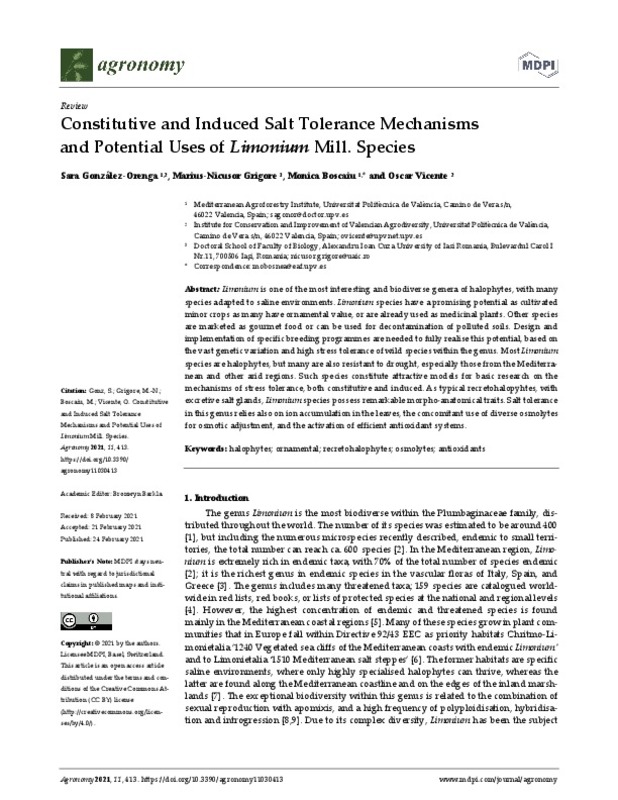JavaScript is disabled for your browser. Some features of this site may not work without it.
Buscar en RiuNet
Listar
Mi cuenta
Estadísticas
Ayuda RiuNet
Admin. UPV
Constitutive and Induced Salt Tolerance Mechanisms and Potential Uses of Limonium Mill. Species
Mostrar el registro sencillo del ítem
Ficheros en el ítem
| dc.contributor.author | González-Orenga, Sara
|
es_ES |
| dc.contributor.author | Grigore, Marius-Nicusor
|
es_ES |
| dc.contributor.author | Boscaiu, Monica
|
es_ES |
| dc.contributor.author | Vicente, Oscar
|
es_ES |
| dc.date.accessioned | 2022-05-30T18:05:07Z | |
| dc.date.available | 2022-05-30T18:05:07Z | |
| dc.date.issued | 2021-03 | es_ES |
| dc.identifier.uri | http://hdl.handle.net/10251/182992 | |
| dc.description.abstract | [EN] Limonium is one of the most interesting and biodiverse genera of halophytes, with many species adapted to saline environments. Limonium species have a promising potential as cultivated minor crops as many have ornamental value, or are already used as medicinal plants. Other species are marketed as gourmet food or can be used for decontamination of polluted soils. Design and implementation of specific breeding programmes are needed to fully realise this potential, based on the vast genetic variation and high stress tolerance of wild species within the genus. Most Limonium species are halophytes, but many are also resistant to drought, especially those from the Mediterranean and other arid regions. Such species constitute attractive models for basic research on the mechanisms of stress tolerance, both constitutive and induced. As typical recretohalopyhtes, with excretive salt glands, Limonium species possess remarkable morpho-anatomical traits. Salt tolerance in this genus relies also on ion accumulation in the leaves, the concomitant use of diverse osmolytes for osmotic adjustment, and the activation of efficient antioxidant systems. | es_ES |
| dc.description.sponsorship | Work in the authors' laboratories was funded by Generalitat Valenciana, grant AICO/2017/039. | es_ES |
| dc.language | Inglés | es_ES |
| dc.publisher | MDPI | es_ES |
| dc.relation.ispartof | Agronomy | es_ES |
| dc.rights | Reconocimiento (by) | es_ES |
| dc.subject | Halophytes | es_ES |
| dc.subject | Ornamental | es_ES |
| dc.subject | Recretohalophytes | es_ES |
| dc.subject | Osmolytes | es_ES |
| dc.subject | Antioxidants | es_ES |
| dc.subject.classification | BOTANICA | es_ES |
| dc.subject.classification | BIOQUIMICA Y BIOLOGIA MOLECULAR | es_ES |
| dc.title | Constitutive and Induced Salt Tolerance Mechanisms and Potential Uses of Limonium Mill. Species | es_ES |
| dc.type | Artículo | es_ES |
| dc.identifier.doi | 10.3390/agronomy11030413 | es_ES |
| dc.relation.projectID | info:eu-repo/grantAgreement/GENERALITAT VALENCIANA//AICO%2F2017%2F039//MECANISMOS DE TOLERANCIA A ESTRES HIDRICO Y SALINO EN PLANTAS ENDEMICA, RARAS O AMENAZADAS, E IMPLICACIONES PARA SU MANTENIMIENTO O REINTRODUCCION EN EL PARC NATURAL DE L'ALBUFERA./ | es_ES |
| dc.rights.accessRights | Abierto | es_ES |
| dc.contributor.affiliation | Universitat Politècnica de València. Departamento de Ecosistemas Agroforestales - Departament d'Ecosistemes Agroforestals | es_ES |
| dc.contributor.affiliation | Universitat Politècnica de València. Departamento de Biotecnología - Departament de Biotecnologia | es_ES |
| dc.description.bibliographicCitation | González-Orenga, S.; Grigore, M.; Boscaiu, M.; Vicente, O. (2021). Constitutive and Induced Salt Tolerance Mechanisms and Potential Uses of Limonium Mill. Species. Agronomy. 11(3):1-23. https://doi.org/10.3390/agronomy11030413 | es_ES |
| dc.description.accrualMethod | S | es_ES |
| dc.relation.publisherversion | https://doi.org/10.3390/agronomy11030413 | es_ES |
| dc.description.upvformatpinicio | 1 | es_ES |
| dc.description.upvformatpfin | 23 | es_ES |
| dc.type.version | info:eu-repo/semantics/publishedVersion | es_ES |
| dc.description.volume | 11 | es_ES |
| dc.description.issue | 3 | es_ES |
| dc.identifier.eissn | 2073-4395 | es_ES |
| dc.relation.pasarela | S\430840 | es_ES |
| dc.contributor.funder | GENERALITAT VALENCIANA | es_ES |








